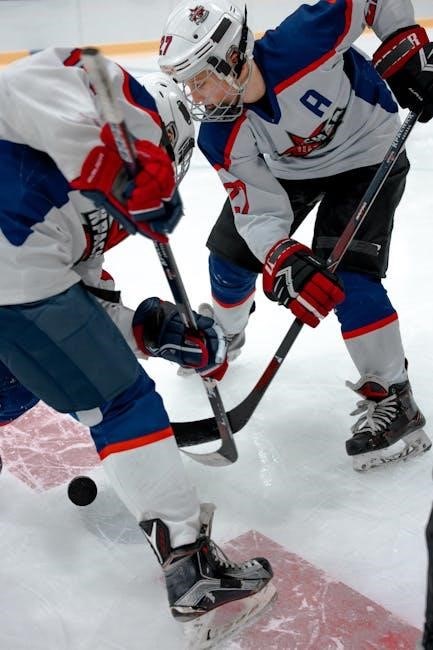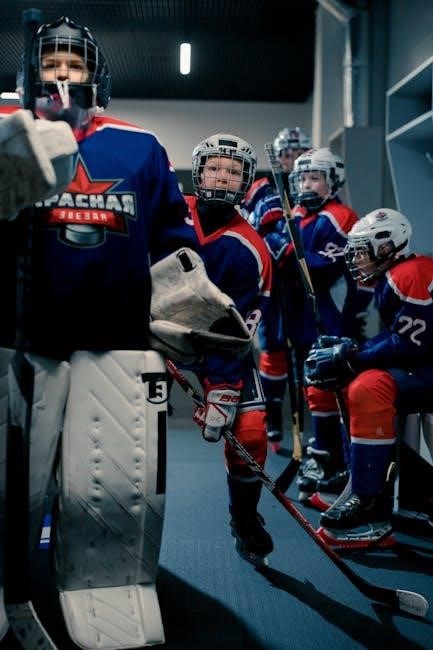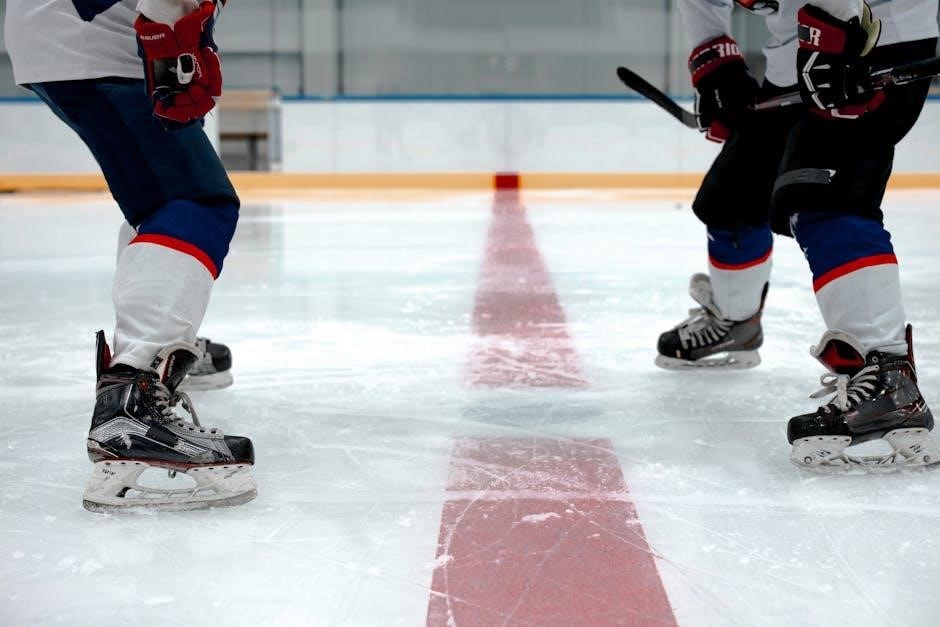Proper hockey stick sizing is crucial for optimal performance, control, and comfort. The right fit enhances skill execution, ensuring players can handle the stick effectively during games.
Why Proper Fit is Essential for Performance
A properly fitted hockey stick is vital for maximizing performance, as it directly impacts control, accuracy, and comfort. A stick that is too long or too short can hinder movement and balance, affecting shooting and passing precision. Additionally, improper fit can lead to fatigue and discomfort during games, distracting players from their focus. The right size ensures optimal energy transfer when striking the puck, enhancing power and accuracy. It also allows for better puck control and maneuverability, which are critical for skilled play. A well-fitted stick not only elevates performance but also reduces the risk of injury, making it a cornerstone of a player’s equipment.
Key Factors in Choosing the Right Stick
When selecting a hockey stick, several key factors come into play to ensure the best fit and performance. Length, flex, and curve pattern are the primary considerations, each influencing how the stick handles and responds. Length affects reach and control, while flex determines the stick’s stiffness and energy release during shots. The curve pattern impacts puck control and shooting accuracy, varying based on personal preference and playing style. Weight and material composition also matter, as lighter sticks enhance agility, and durable materials improve longevity. Additionally, personal comfort and position-specific needs, such as forward or defenseman, guide the selection process, ensuring the stick complements the player’s skills and game strategy effectively.

Determining the Correct Length of a Hockey Stick
Length is measured from the stick’s heel to the top of the shaft. Stand without skates, and the stick should reach your nose for optimal control and reach.
Using Height as a Primary Measurement
Height is the most common starting point for determining stick length. Stand without skates, and the stick should reach just below your nose for proper fit. For most players, this results in a stick length between 36.5 and 38.5 inches. However, personal preference and skating style can influence this measurement. Taller players may need longer sticks, while shorter players opt for shorter ones. Testing the stick by holding it upright and ensuring it feels comfortable is essential. This method ensures the stick is proportional to your body, allowing for better control and maneuverability during gameplay. Proper height alignment enhances performance and reduces fatigue.
Considering Reach and Comfort
Reach and comfort are critical when selecting a hockey stick. The stick should allow you to stand comfortably with your skates on, maintaining a slight bend in your knees. When holding the stick, your arms should be slightly bent, with the blade touching the ground. A stick that is too long can compromise control, while one that is too short may limit your reach. Personal preference plays a role, as some players prefer a shorter stick for better mobility, while others opt for a longer one for increased power. Testing the stick by holding it and moving naturally helps ensure the right fit for your body and style.
How Playing Style Influences Stick Length
Playing style significantly impacts the choice of hockey stick length. Taller players often prefer longer sticks for added reach, while shorter players may opt for shorter sticks to maintain control. Forwards tend to favor slightly shorter sticks for quicker handling and agility, whereas defensemen often choose longer sticks for better reach and blocking ability. Goalies typically require sticks with unique specifications due to their position demands. Ultimately, the stick length should align with how you move and play on the ice. Testing different lengths during drills or scrimmages can help determine the ideal fit for your specific style and role in the game.

Understanding Stick Flex and Its Importance
Stick flex measures a stick’s stiffness, impacting performance. Proper flex enhances shot power and accuracy, while incorrect flex reduces control and energy transfer during plays.
What is Flex and How is it Measured?
Flex refers to the stiffness of a hockey stick, determined by how much it bends under force. It’s measured using a deflection test, where a weight is applied to the shaft, and the bending distance is recorded in inches. Common flex ratings range from 40 to 100, with lower numbers indicating a softer stick and higher numbers a stiffer one. Players’ weight, strength, and position influence the ideal flex, as it affects shooting power and passing accuracy. Proper flex ensures optimal energy transfer during gameplay, making it a critical factor in stick selection.
Choosing the Right Flex for Your Weight and Position
Choosing the right flex involves considering a player’s weight, position, and playing style. Lighter players typically use softer flex sticks for better control, while heavier players prefer stiffer sticks for power. Forwards often opt for medium to high flex to balance shooting and stickhandling, while defensemen prefer higher flex for slapshots and durability. Goalies use extra stiff sticks for better blocking. Proper flex ensures efficient energy transfer, improving performance. It’s essential to test different flex levels to find the best fit, as personal preference plays a significant role in optimizing gameplay. The right flex enhances both accuracy and power, making it a key factor in stick selection.

The Role of the Stick’s Curve Pattern
The curve pattern significantly impacts shooting accuracy and puck control. It determines how the puck behaves off the blade, enhancing performance for specific playing styles.
Common Curve Patterns and Their Benefits
There are several common curve patterns, each designed to suit different playing styles. The “mid curve” offers balanced control and shooting accuracy, ideal for versatile players. A “deep curve” enhances puck control and stickhandling, favored by playmakers. Conversely, a “slight curve” provides a quicker release and is preferred by goal scorers. The “straight blade” is rare but useful for precise passing. Understanding these patterns helps players choose a stick that aligns with their strengths, improving overall performance on the ice. Each curve type caters to specific skills, making it essential to test and find the one that complements your game.
How to Select the Best Curve for Your Shooting Style
Selecting the right curve for your shooting style is vital for maximizing accuracy and control. If you’re a sniper who relies on quick releases, a slightly open or mid-curve blade is ideal. For playmakers, a deeper curve enhances puck manipulation and saucer passes. Goalies often prefer a straighter blade for better blocking and clearance. Consider your shot type—wrist, snap, or slap—and how the curve affects puck trajectory. Testing different curves during practice helps identify the best fit. The right curve aligns with your strengths, elevating your performance and confidence on the ice. Match your style to the blade’s contour for optimal results.

Material and Construction of Hockey Sticks
Modern hockey sticks are made from advanced materials like carbon fiber, fiberglass, and wood, offering durability, lightweight feel, and enhanced performance for precise puck control and powerful shots.
Types of Materials Used in Modern Sticks
Modern hockey sticks are crafted from a variety of high-performance materials, including carbon fiber, fiberglass, and hybrid combinations. Carbon fiber is prized for its lightweight and exceptional strength, enabling faster swing speeds and precise control. Fiberglass offers durability and flexibility, making it ideal for players who prioritize impact resistance. Hybrid sticks blend these materials to balance weight, strength, and cost. Additionally, some sticks incorporate wood for traditional feel, though they are less common in elite play. The choice of material significantly impacts the stick’s performance, longevity, and overall playing experience, catering to different preferences and skill levels among players.
Impact of Material on Performance and Durability
The material of a hockey stick significantly impacts its performance and longevity. Carbon fiber sticks are lightweight, offering faster swing speeds and better precision, while fiberglass provides durability and flexibility. Hybrid sticks combine these materials for a balance of strength and cost-effectiveness. Wood sticks, though less common, offer a traditional feel but may lack in durability compared to modern alternatives. Higher-end materials like carbon fiber are favored by elite players for their responsiveness, but they can be more expensive. The choice of material directly influences the stick’s performance, with lighter, stronger sticks enhancing power and accuracy, while durable options withstand rigorous play, ensuring a longer lifespan for the equipment.

Advanced Features to Consider
Advanced features like customization, blade shape, and ergonomic grips enhance performance. These innovations allow players to tailor sticks to their style, improving puck control and shot accuracy.
Customization Options for Personalized Fit
Customization options allow players to tailor hockey sticks to their preferences, enhancing performance. Blade shape, stick length, and flex can be adjusted for precise control and comfort. Additionally, materials and aesthetics, such as color and graphics, can be personalized. Advanced manufacturing techniques enable players to design sticks that meet their specific needs, ensuring a perfect fit and optimal gameplay. Customization options are particularly beneficial for elite players seeking a competitive edge. By personalizing key features, players can maximize their skills and enjoy a more comfortable, efficient on-ice experience. This level of personalization is now more accessible than ever, thanks to modern technology and online customization platforms.
Blade Shape and Its Effect on Puck Control
Blade shape significantly influences puck control and handling. A more rounded blade provides better puck feel and control, while a flatter shape allows for quicker releases and accurate shooting. Players often choose blade shapes based on their position and style of play. Forwards tend to prefer a more rounded blade for precise stickhandling, while defensemen may opt for a flatter shape to enhance passing accuracy. The blade’s lie, or angle, also plays a role in puck control, with varying lies offering different levels of comfort and performance. Selecting the right blade shape ensures optimal puck manipulation and enhances overall gameplay effectiveness for players of all levels.

Practical Tips for Buying a Hockey Stick
Test the stick before purchasing to ensure proper fit and comfort. Consider your playing style, position, and personal preferences to make an informed decision.

Trying Before Buying: Importance of Testing
Testing a hockey stick before purchasing is essential to ensure it feels right for your height, reach, and playing style. Stand with the stick on the floor, grip it as you would during a game, and assess its length and balance. Try it on the ice or floor, performing drills like shooting and passing to gauge comfort and control. Pay attention to how the stick flexes and whether it suits your strength. Testing helps confirm the stick’s weight, flex, and curve pattern are ideal for you, ensuring a perfect fit and optimal performance during games.
Maintenance and Care for Longevity
Proper maintenance ensures your hockey stick lasts longer and performs optimally. Regularly clean the blade and shaft with a damp cloth to remove dirt and tape residue. Avoid exposing the stick to extreme temperatures, as this can weaken the materials. Store the stick in a dry place, away from direct sunlight. After games or practices, inspect for cracks or damage, and address them promptly. Replace worn-out tape to maintain grip and control. By following these care tips, you can extend the life of your stick and ensure consistent performance on the ice.

No Responses